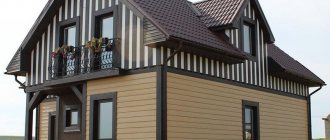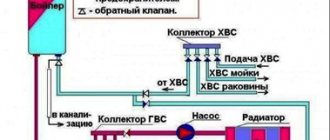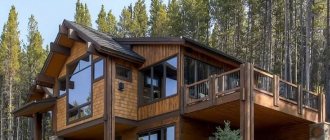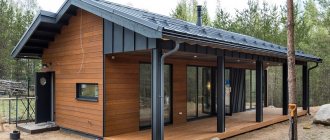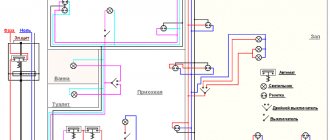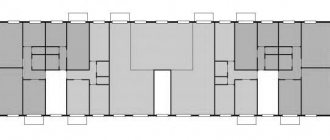The houses of the first are small, with stove heating and without amenities. The latter have three-story mansions with designer renovations.
But the middle class usually prefers apartments.
In my opinion, this judgment is fundamentally wrong. The house is not inferior at all, and in many ways even surpasses the apartment in many respects.
This is our psychology, and it’s difficult to fight it. But I will try to break these stereotypes. I will tell you who is better off living in a private house, and why this is so.
Young families
I know this not by hearsay, but from my own experience.
As soon as my new family faced the question of where to live, my husband and I unanimously declared: “Only in our own home!” And they bought a house in a small town, from where you can get to work in the same amount of time as others get from the outskirts.
And we have never regretted it.
Yes, a house requires larger financial investments. Yes, you have to work harder here too. But what are the prospects for development
! Gradually, even from the most run-down shack you can make the home of your dreams.
In addition, I noticed: in a private house and an apartment of equal size, the limited space is felt differently. The house still seems larger due to the adjacent territory, which is essentially also your home.
I have formulated a list of main advantages
private house for a young family:
1. For your (future) children the opportunity to grow up in the fresh air
simply invaluable. This is an undoubted benefit for their health and development, mental and physical.
2. You don't have intrusive neighbors
who are disturbed by every sound. This not only means that you can party late into the night with friends. In the end, you don’t have to worry that the whole neighborhood will witness your intimate life.
3. If you have a small house and there is not enough room for a child, you can complete it
her as soon as the need arises. And it's not that expensive. With the right approach, every family can afford this.
4. Start a practice of romantic dinners in nature
at least once a week (and ideally throughout the warm season). This will refresh and strengthen your relationship with your spouse.
5. Finally, the average house costs less.
average apartment. And for young families this argument is often decisive.
If you want to be truly free and independent, choose a private home.
Types of cables and selection rules
PBPP cable
The selection of cables depends on the power of the devices that are connected to the power line.
Varieties:
- PBPP or PUNP. Flat, with single-wire copper conductors, cross-section 1.5 - 6 mm2. PVC insulation, used at +15° - +50°C. Transmits current 250 V, frequency - 50 Hz.
- PBPPg or PUGNP. Flexible, stranded, bending radius - 6 diameters, other parameters are the same as the previous wire.
- APUNP. It has a single-wire copper core, cross-section - 2.5-6 mm². The standards provide a tolerance for the cross-section of the shell and core of 30%.
- PPV (copper), APV (aluminum). The wires are distinguished by PVC jumpers between 2-3 cores with a cross-section of 0.8-6 mm². They transmit a current of 450 V, frequency 400 Hz.
PUGNP APUNP PPV
Single-core cables APV (aluminum), PV1 (copper), flexible PV3, APV, ShVVP are used. Power - VVG (moisture-proof), AVVG (aluminum insulated) transmit a current of 1000 V and a frequency of 50 Hz.
Core cross-section
The diameter of the core must comply with standard indicators.
If it is shown that the cable is 2 x 2.5, then the cross-section should be 2.5 mm². In fact, the size differs by 10–20%, sometimes more. As a result, the insulation melts and an emergency situation occurs. The cable cross-section can be determined by its diameter:
- use a caliper or an electronic and mechanical micrometer;
- the insulation is removed from the core;
- measure the diameter;
- Using the formula for the area of a circle, find the real cross-section.
It is not always convenient to do calculations in the store, so there are special tables for finding the cross-section by diameter. It has running sizes of cores. The cables are equipped with a tag indicating the cross-section, for example, ВВН 2 x 4. The number 4 is of interest, indicating a cross-section of 4 mm². Compliance is checked using the table.
Shell
The insulation protects against contact with a live wire, and you can also place several wires side by side without the risk of causing a short circuit.
Shells used:
- PVC (polyvinyl chloride) . It is inexpensive, has high characteristics: wear resistance, flexibility. The material does not burn and withstands household chemicals. Does not tolerate strong heating and negative temperatures.
- Rubber. The wear-resistant coating prevents moisture penetration and does not reduce flexibility.
- Polyethylene n. They are classified as high-quality dielectrics, resistant to aggressive chemicals and sunlight. Low flexibility.
- Silicone. When heated and melted, it forms a film, which is a reliable dielectric. As a result, in emergency situations, the risk of short circuits and fires is reduced.
Paper with different impregnations is also used, and the properties depend on the processing characteristics. Carbolite is also classified as a dielectric with increased fragility. In addition to conductor sheaths, they are used for socket boxes
Criterias of choice
The optimal choice for home electrical wiring is cables with aluminum conductors.
Aluminum conductors are cheaper, but in terms of electrical conductivity they are in 4th place after copper, silver and gold. This material reduces the cost of cable production, it is chemically stable, has high heat transfer, and weighs little.
Factors taken into account when purchasing :
- ability to withstand stress;
- the ability not to change qualities when heating and cooling to minus values;
- for shells, the ability not to collapse when exposed to direct rays of the sun is important;
- What matters is the tensile strength indicator.
In terms of its ability to conduct current, copper is in second place after silver, inferior to it by 5%. Compared to aluminum, the conductivity is 1.65 times higher. The material is quite elastic and flexible, even if we are talking about a single-core wire. No additional materials are required for joining by tinning and soldering.
Creative people
Yes, a private house provides real space for your imagination to fly. You can create without holding back your creativity in any way.
Firstly
, you can put your creativity to good use when building a house.
Secondly
, its finishing and design will also allow you to roam.
What about landscape design? Well, there's nothing to say here. Only the lazy would not want to express themselves by creating an ideal recreation area.
But a private home promotes creativity not only in this sense. Fresh air breathes new ideas into you, and the absence of neighbors behind the wall allows you to implement them whenever you please.
You can play the piano all night.
You can sculpt sculptures and decorate your garden with them.
For example, I became interested in knitting. Yes, I could do this in the apartment, but working in the fresh air is much more pleasant.
In a word, a private home inspires and inspires. Even those who were previously far from creativity.
Current legislation on neighbor relations in the private sector
Neighborhood disputes are settled on the basis of the following provisions:
- Land Code. This sets out the rights and obligations of citizens using land plots under ownership or under a lease agreement.
- Town Planning Code. The principles according to which construction is carried out and the sanitary standards that control this process are prescribed here.
- Civil Code. It contains articles explaining the procedure for resolving property disputes.
- FZ-498. Indicates standards for keeping animals in the private sector.
- FZ-217. Regulates the conduct of gardening and vegetable gardening.
Consideration of problematic issues falls on city and municipal authorities and courts.
Athletes
There’s nothing to say here, but I’ll still write a few words.
First of all, you can organize a gym right in your home
or in the basement. Or maybe you have an empty garage? Well, convert it into a gym!
What could be better than training outdoors
? You can create a sports complex in your yard. And sometimes improvised means are enough. At least you can get by with a minimum investment.
And this training area will be only yours! You will no longer wait for the horizontal bar to become free. You will no longer depend on the opening hours of the sports club.
In any case, your home helps improve physical fitness. After all, you need to work hard here, and you will improve your health and increase muscle mass without even noticing.
By the way, for the same reason I would recommend buying a house for those who want to lose excess weight
. Here you definitely won’t have any problems with this.
Keeping pets
The pet category includes not only cats and dogs, but also pigs, chickens, goats, etc. To prevent their presence from causing problems, animal owners must adhere to the following standards:
- Before getting pets, check that this does not conflict with local laws established by the village administration.
- Create conditions for their living in a designated area.
- Take care of your pets daily: clean their cages, feed them, and prevent them from leaving the area.
In addition, products obtained from animals, such as milk or meat, cannot be used for sale. Such actions are regarded as unregistered business activity.
Hermits
You may not leave the house for weeks
? Are you not eager to communicate with intrusive neighbors? So exchange your apartment for a house, surround it with a high fence - and you will be left alone with yourself!
You can do anything
. You can sleep all day. Or meditate. Or grow flowers.
In the end, browse the Internet and live a virtual life if that appeals to you more.
A private home will free and protect you from a society that is unpleasant to you. No matter how hard you try, you won’t be able to do this in an apartment.
Ground loop
Externally, the device is represented by a structure of electrodes dug into the ground (at least two meters long), which are welded at the top with strip metal. From them comes a grounding wire in the form of flat or round steel. The cable extends to the in-house distribution panel and is connected to the terminals with copper wire.
There are different grounding schemes :
- Closed. Three steel pins are driven into the ground in a triangle. The advantage is that if one rod does not work, the remaining parts will remain functional.
- Linear. The stakes are driven in sequentially and connected with a steel strip. The circuit is simpler to manufacture, but works less reliably.
The designs are improved, for example, the base is made of a rectangle or oval, but it is not recommended to use less than three rods.
Amenities for the “iron horse”
There is always a place to park a car on your own site, and over time they plan to build at least a shed, or even a major heated garage. When you arrive from work, you don’t have to poke around looking for a free space, like in an apartment, and then constantly listen for the howling alarm. By the way, to wash your car, you also don’t need to go somewhere and pay for a stream of water with a soap additive.
Binding
vovadzeFORUMHOUSE Member
A couple of years ago I completed a house, I live in it, everything is fine, but there is one unpleasant nuance, the house is not an apartment that you can lock and go on vacation somewhere warm, especially in winter!
Anti-freeze cannot be poured into every heating system, and even the most “smart” appliances cannot be left unattended for a long time. And a residential building without heating quickly falls into disrepair. Not to mention situations where you have a subsidiary plot, you either have to call your relatives 24/7 or negotiate with your neighbors. Therefore, before even getting chickens, it is worth considering that we are responsible for those we have tamed, in this case, bred.
Other rules that respect the interests of neighbors
The private sector gives people the opportunity to realize themselves in different roles. Residents of such land plots have the opportunity to engage in construction, gardening, keeping animals - but these are not all ways to spend their time. However, the organization of any activities should not become dangerous to the health or property of neighbors in the area. Therefore, there are a number of rules introducing a ban on:
- Inappropriate use of land. This means the organization of commercial activities, car service, workshop, etc.
- Launch of the site. This violates the sanitary and epidemiological requirements that control the maintenance of hygiene on the site. Residents are responsible for removing trash and mowing the grass to keep the property in good condition.
- Improper waste disposal. Garbage must be disposed of only in designated areas where containers are located. It should not be burned on the land, as such actions can lead to fires or poisoning by toxins.
- Harm to the environment. Residents cannot drill wells, cut down forests, or treat plants with pesticides. All this harms the condition of the soil, worsens the environmental situation and the quality of life of residents of neighboring areas.
We recommend reading:
Real Estate Registration Law
If such violations are recorded, neighbors may sue. The occurrence of a relapse may lead to the deprivation of the rights to use the land plot from the owners.
Placement of structures without violating the law
Placing buildings on land is often the reason for increasing land taxes, as well as a frequent cause of disputes between neighbors. This is due to the following reasons:
- the process of determining who is responsible for the determination;
- demands to move the building away from someone else’s border;
- requirements not to put up buildings, since the shadow prevents sunlight from entering.
To regulate all controversial issues, the competent authorities turn to the rules for the construction of construction projects.
Fence installation
Typically, to install a fence, neighbors make equal contributions to cover the cost of this service. Situations are also possible in which one neighbor takes full responsibility for the installation if the other cannot afford to allocate funds for this.
A constructed object is called legal in cases where:
- it does not interfere with the penetration of air and light;
- it repeats officially established boundaries;
- its height is no more than 1.5 m.
If appropriate agreements exist between neighbors, a blind fence can be placed on the site. To do this, it is worth obtaining the written consent of the owners of the neighboring plot. If it is not available, a blind fence can also be installed, but it must lie a meter from the established border. At the same time, it is placed in the plan in the form of a capital building.
The neighbor's written permission helps in that it prevents the problems of further litigation with the neighbor due to problems with placing a fence on the property.
Sometimes situations arise in which neighbors agreed verbally, but then had a fight, and the owner of the neighboring property demands that the fence be demolished. If he goes to court, having his written permission will help dismiss the claim to demolish or change the position of the fence.
Planting plants on the border of the site
In addition to tall buildings, light can be blocked by plants. In addition, neighbors may harvest someone else's crops growing close to the common border, as they consider it common property. To prevent such problems, the following planting rules must be observed:
- bushes should be located at a distance of 1 m from the adjacent fence;
- medium-sized trees - at a distance of 2 m from the fence;
- large and tall plantings - at a distance of 4 m.
The distance for measurement is calculated from the border of the fence to the trunk.
If the rules are not followed, neighbors may take the harvest and initiate the cutting down of other people's plants. Therefore, it is worth planting green spaces in the common area only after a joint agreement.
